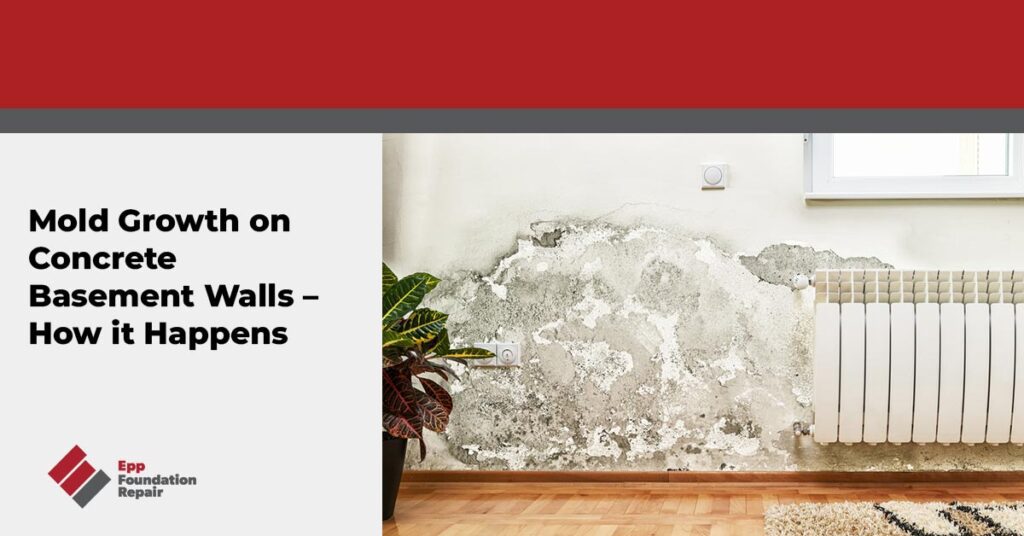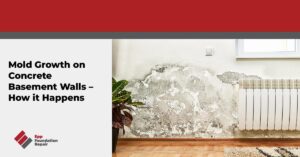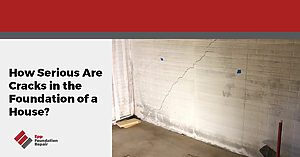Searching for information on whether or not concrete can grow mold? If so, don’t hit that back button because that’s what we’re going to talk about in this article. We’re going to discuss what causes mold on concrete, how to get rid of mold on concrete, how to prevent it, and more.
Can Concrete Grow Mold?
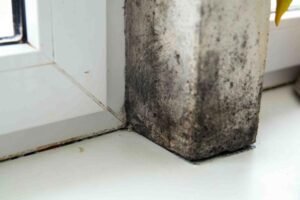
Yes, mold can grow on concrete. While concrete is not a food source for mold, it can provide a damp and humid environment that allows mold spores to grow. In other words, any moisture or dampness on the concrete surface can lead to mold growth. This is especially true in areas with high humidity or concrete surfaces constantly in contact with water.
It’s important to keep concrete surfaces dry and well-ventilated to prevent mold growth from occurring. So, while concrete itself cannot grow mold, it can certainly provide a breeding ground for unwanted fungi if proper precautions aren’t taken.
What Causes Mold Growth On Concrete?
Mold will grow on damp concrete surfaces. In other words, anywhere there is high humidity, condensation, or water infiltration (i.e., water seeping through your foundation walls via cracks you didn’t even know were there). Mold also likes temperatures from 40-120F. These conditions provide the perfect environment for mold spores to thrive and spread rapidly, leading to potential health hazards and damage to your property.
Understanding what causes mold growth on concrete and taking preventative measures can help you avoid this troublesome issue and keep your home or business healthy and safe.
Is It Mold, Or Is It Efflorescence?
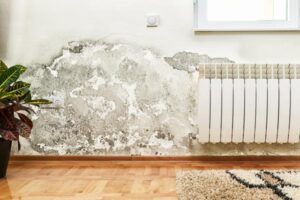
Often, homeowners notice a white, powdery substance on their basement walls or floors and assume it’s mold. It’s actually something called efflorescence, a fancy term for salt crystals forming on the surface of masonry and other building materials, including concrete basement walls. Efflorescence occurs when moisture that contains salts is drawn out from within the material and crystallizes on its surface. Efflorescence poses no health risks. Mold, on the other hand, is a type of fungus that can pose health risks.
One easy way to determine if it’s mold or efflorescence is to spray the area with water. If the discoloration disappears when wet, it’s efflorescence. If it doesn’t, it’s mold.
While both efflorescence and mold can be unsightly, it’s essential to correctly identify which-is-which to address it effectively.
Problems Associated With Mold Growth On Concrete
Mold growth on concrete can lead to serious problems that can affect both the structural integrity of your home and the health of its occupants.
Structural integrity compromised
Mold growth can weaken concrete and make it more porous. This can not only compromise the structural integrity of your home but can also make it more susceptible to water infiltration.
Health issues
When mold grows on the surface of concrete, it releases spores that can cause respiratory and allergy problems. These health issues can be particularly severe in people with preexisting breathing disorders.
It’s critical to address mold growth on concrete as soon as possible to prevent these types of problems from occurring.
How To Get Rid Of Mold On Concrete Basement Walls
Dealing with mold can be a hassle, especially when it spreads on concrete basement walls. If the mold on your basement wall is spread over a large area, it’s best to call a professional mold remediation company and let them handle it.
If it’s a small area of mold, the best solution is to use a strong fungicide that will kill the mold at its source. Before applying the fungicide, thoroughly clean the walls with a mixture of bleach, water, and detergent. Once the walls are clean, follow the instructions on the fungicide and apply it directly to the affected areas. With a bit of patience and elbow grease, your basement walls will be mold-free in no time.
How To Prevent Mold On Concrete Basement Walls
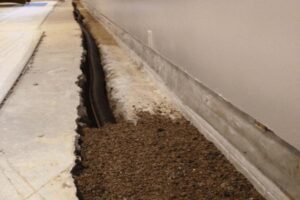
You can prevent mold growth on concrete basement walls by making sure your basement is dry. The best way to get a dry basement is to prevent excess moisture from building up in the soil around the foundation. You can do this by installing a drain tile system.
How a drain tile system works
When it comes to basement waterproofing, nothing beats a drain tile system. It is, by far, the best foundation waterproofing method available today. It’s the most effective waterproofing solution because it doesn’t merely put up a barrier to keep water out; it prevents excess soil moisture, to begin with. If there’s no excess moisture in the soil around your home’s foundation, there’s no excess moisture to make its way inside your basement.
There are two types of drain tile systems, exterior and interior. The exterior design is installed around the outside perimeter of your foundation at the footing level. An interior drain tile system is installed around the inside perimeter of your basement and requires breaking up the concrete floor to dig a shallow trench and lay the drainage pipe. For more information about drain tile systems, see Basement Drain Systems: The Secret To A Dry Basement.
Other ways to help keep your basement walls dry and mold-free
While a drain tile system is the best way to prevent moisture and mold growth on concrete basement walls, there are some other things you can do as well. These include the following:
- If necessary, regrade the yard around your home so that it slopes away from the foundation. This will stop groundwater from draining toward the foundation and causing problems.
- Consider relocating any water-hungry shrubs or flowers planted next to your house. They might look beautiful, but they need water.
- Use downspout extensions to carry runoff at least four feet from your foundation before release. Downspout extensions are inexpensive and easy to install.
- Clean your gutters regularly so they aren’t clogged with decaying leaves and other debris. This can cause water to spill over the side of your house and soak into the ground around the foundation.
- Install an underground downspout and pop-up emitter. Runoff flows into the underground downspout and toward the pop-up emitter situated somewhere in your yard several feet from the foundation. When the emitter fills with water, it pops up and releases it away from the foundation.
If you’re concerned about mold on your concrete basement walls, contact us today to schedule an evaluation. Since 1994, we’ve helped clients in Lincoln, Omaha, Kearney, Southeastern Nebraska, Northwestern Missouri, and parts of Northeastern Kansas with foundation repair, basement waterproofing, crawl space encapsulation, and concrete leveling for their homes.

